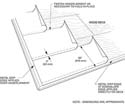Insurance is a significant cost for roofing contractors, and workers' compensation is a substantial part of insurance. Because your experience modification rate (EMR) directly affects your premium, it is essential you understand how your EMR is calculated.
Each state has certain workers' compensation premium rates, and an EMR is based solely on a roofing contractor's individual performance. Following is an explanation of EMRs and how they are calculated.
EMRs
States calculate an EMR, called a factor, for each business owner (above a given premium size depending on the state) to compare that business's loss history with the average history for that type of business. An EMR is meant to provide business owners with a financial incentive to provide a safe workplace. Having an EMR of 1.00 is average. With an EMR below 1.00, you will have earned a credit and your premium will be lower than the average in your state. If your EMR is above 1.00, you will have a debit and your premium will be higher.
A state determines its "class average losses" for roofing companies by adding all roofing losses reported in the state for the past several years (number of years varies by state) and dividing that number by the state's total roofing payroll reported from the past several years (again, number of years varies by state). The result is an average "loss rate" expressed as a percentage of payroll. The loss rate of a company is studied each year and adjusted for benefit level changes and inflation when necessary.
The class averages are used when each roofing firm is experience-rated. The firm's payroll is multiplied by its state's loss rate to calculate what "average losses" should be for a roofing firm of its size. The roofing firm's actual losses are compared with this average figure to determine whether the roofing firm is better or worse than average. The comparison is done with three years of the roofing firm's payroll and loss data to get a better picture of the roofing firm's long-term commitment to safety and ease the financial effect of an unlucky year with large losses.
The current year is left out of the experience-rated three-year period because it is not yet complete when the state calculates the EMR.
Losses
Note that a bad loss in a current year won't show up in the next year's factor. It first will show up in the factor for the year after the next year. In addition, once a bad loss hits the experience period, it stays there for three years. It will affect three years' EMR calculations and will, therefore, affect three years of workers' compensation premiums.
When looking at frequency or severity of accidents, actuaries reason that frequency is more significant than the dollar amount of losses when comparing an individual roofing firm's experience with average experience for the class. The rationale is that a roofing contractor can do more to prevent injuries than to control the cost after injuries have occurred. Therefore, the EMR formula gives greater weight to frequency of losses than to the dollar value of the losses.
For experience-rating purposes, losses are split into separate frequency and severity portions. The first $5,000 of any loss is considered primary loss. All primary losses count against the roofing firm in its comparison to average performance. The remainder of any loss (the portion above $5,000) is called excess loss. Only a fraction of total excess losses count against the roofing firm in its comparison of actual losses to average performance. The fraction used increases with the size of the roofing firm's payroll. Therefore, large roofing contractors are held more accountable for severity than small roofing contractors.
Producing data
To generate EMRs for businesses in their states, most states contract with the National Council on Compensation (NCCI). You should work with your insurance agent or broker to confirm your accuracy with regard to calculations. EMRs are calculated using payroll and loss data contained on unit statistical cards submitted annually by insurers for each account they insure. Before unit statistical cards are submitted, make sure the insurer has deleted reserves on closed claims; updated the reserve values for open claims; and reported accurate payroll and loss data.
Note that after unit statistical cards have been submitted to NCCI, subsequent reserve reductions won't affect EMRs until the following year.
For further information about NCCI, log on to www.ncci.com.
Being aware of insurance processes is an important facet of the roofing industry. Be certain you understand your EMR so you can understand its effect on your insurance.
Leslie Kazmierowski is NRCA's insurance programs manager.


